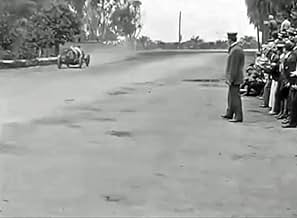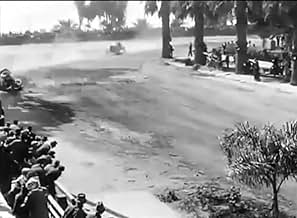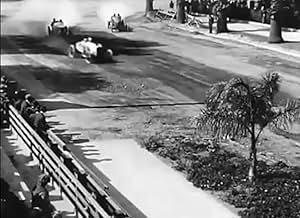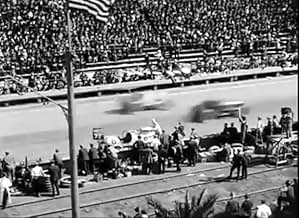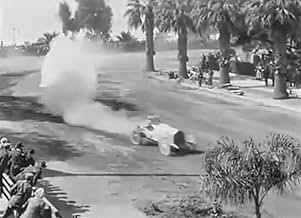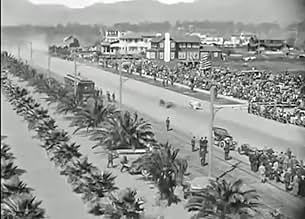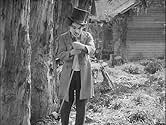Ajouter une intrigue dans votre langueCharlie, competing with his rival's race car, offers Mabel a ride on his motorcycle but drops her in a puddle. He next joins some dubious characters in abduction of his rival just before the... Tout lireCharlie, competing with his rival's race car, offers Mabel a ride on his motorcycle but drops her in a puddle. He next joins some dubious characters in abduction of his rival just before the race for the Vanderbilt Cup. With her boyfriend locked up in a shed, Mabel takes his plac... Tout lireCharlie, competing with his rival's race car, offers Mabel a ride on his motorcycle but drops her in a puddle. He next joins some dubious characters in abduction of his rival just before the race for the Vanderbilt Cup. With her boyfriend locked up in a shed, Mabel takes his place. Charlie does what he can to sabotage the race, even causing Mabel's car to overturn.
- Réalisation
- Scénario
- Casting principal
- Henchman
- (as Andy Anderson)
- Cheering Spectator
- (non crédité)
- Spectator in Grandstand
- (non crédité)
- Mabel's friend and race spectator
- (non crédité)
- Race Spectator
- (non crédité)
- Spectator in Grandstand
- (non crédité)
- Spectator in Grandstand
- (non crédité)
- Spectator in Grandstand
- (non crédité)
- Cheering Spectator
- (non crédité)
- Henchman
- (non crédité)
Avis à la une
Mabel was all sweetness after the furore, although she was unsure about riding pillion with Charlie on the Keystone motorbike – a type of machine he claimed to have ridden before. According to Mabel, the crazy Briton crashed the bike into a ditch before they'd gone twenty yards. He'd lied! Once he'd mastered the technique, all was set for a mad ride along a muddy track, where the hapless Mabel would be dumped in a mud pool. This was the cue for the usual Keystone battle of bricks between Mabel plus boyfriend and Charlie. Interesting how there are always some handy bricks lying around to be thrown by inmates of Sennett's 'University of Nonsense'. Charlie becomes a Ford Sterling- type villain for this film, and initiates various dastardly deeds, such as sticking a pin into Mabel's leg, thumping her in the face, and tying her boyfriend up. Without wishing to give the whole plot away, Mabel ends up taking over her boyfriend's racing car drive. The whole film is clearly based around a famous race filmed in Santa Monica, where a front wheel breaks off a car at Dead Man's Curve, causing it to overturn in spectacular fashion. Mabel openly enjoys the adulation she receives from the spectators and team at the conclusion of the race. Oh, how the cast adored their Keystone Girl!
Things to Note: [1] Charlie's motorbike is a chain drive 1912 Thor IV model. [2] The No. 4 racing car could be Sennett's own Stutz. [3] It is amusing to see the startled old fellow in shirtsleeves and braces,standing in his garden watching Charlie restart his motorbike – he thinks the Hell's Angels are in town. [4] Many roads around Hollywood in those days were seemingly rutted, muddy tracks. [5] When Mabel and Charlie have a fight, a seated spectator looks bemused,then positively scared.[ 6] The entire Keystone company appears to be in this film. [7] The race team's toolkit consists of one spanner, a file, a hand drill, and a bucket. High-tech that. [8] Mabel thinks race preparation comprises taking out a compact and powdering her nose. [9] The mechanic is in the race car to pump fuel and oil (furiously). [10] When the actual race car crashes, the mechanic is thrown out onto his feet. In the faked keystone crash scene the mechanic ends up under the vehicle.[11] There are plenty enough gags for Charlie in the film, and the lack of the standing on the hose gag (which caused the two stars to fall out) does not detract from the film. [12] Charlie reverts to a type of Ford Sterling costume for this film. Could it be that Mabel refused to work with the Tramp, as she feared being upstaged by the scruffy character? She might also have been fearful of the filthy Tramp outfit (Mrs Arbuckle claimed that Mabel used to buy Charlie new clothing, as he never washed his attire).
Charlie takes Mabel for a ride on his motorcycle but ends up accidentally dumping her in a giant mud puddle. Not surprisingly, she's not happy and she soon goes off with another guy in his race car. Oddly, while this happens right AFTER the mud puddle incident, she's 100% clean...and not a trace of mud.
Charlie is angry he lost her, so he now plots revenge (as you can tell with a bit of overacting by Charlie). He even ends up slugging poor Mabel (which isn't very funny)! This isn't the end to Charlie's nasty behavior--which also includes rock throwing and popping the car's tire. In fact, Charlie is such a jerk you really are rooting for her to run off with Charlie's rival.
In the second part of the comedy, there is a big race and Charlie and his goons kidnap the rival so that he cannot race. So, it's up to Mabel to save the day.
While slapstick comedy is supposed to be violent, seeing Charlie slugging Mabel is terribly unfunny and I cannot imagine audiences of the day liking this, as I've seen hundreds of slapstick films and never recall this sort of behavior. Usually it's more exaggerated and oddly funny. You also see no sign of Charlie's sweet and likable Little Tramp character here...he's just a nasty jerk. Clearly not among Chaplin's best and seeing him behave this way isn't exactly endearing. Fortunately, Chaplin soon stopped playing villain roles and went on to far better things.
In an article called "Speeding Sweethearts of the Silent Screen," film historian William Drew notes that after Mary Pickford's car chase movie "A Beast At Bay" (Griffith, 1912), this is only the third movie to feature a woman's driving. It will only become standard in movies starting in 1915. Drew notes, "In fact, one can view Mabel at the Wheel as a kind of feminist parable with the heroine defeating the male competitors on the race course as well as the villainous Chaplin." Besides seeing Mabel Normand's feminist heroics, the other reason this film, directed by Ms. Normand, is noteworthy is Chaplin's unique performance. He plays the villain wearing a trench coat and whiskers. Through much of the film, he does what seems like a perfect impression of comedian Ford Sterling. At one point, Chaplin even crosses his eyes like Sterling. It should be remembered that Chaplin was hired at Keystone to replace Ford Sterling. In fact Chaplin's tramp costume uses Sterling's large size shoes, perhaps symbolizing the fact that he was hired to fill Sterling's shoes literally as well as figuratively.
The first five minutes of the film is quite different from the rest. Chaplin plays simply Harry McCoy's rival for Mabel Normand. This is exactly the same triangle we saw in Chaplin's first film, "Making a Living." The second five minutes of the film is different with Chaplin suddenly turning into a ridiculous villain caricature. He goes around jabbing people and tires with a pin.
There is a scene where Chaplin takes out a water hose to water a race car course. Apparently, Chaplin refused to do it. Chaplin probably did not see the humor in endangering people's lives. Slapping, punching, pricking and kicking people is one thing, but actually endangering people's lives is another. He worked off the set.
Famously, Mack Sennett threatened to fire him. He submitted and played the rest of the movie as Normand wanted him to, in Ford Sterling absurdist style. We should remember that Chaplin's humor was based on the funny drunk sketch he made famous. The drunk is funny, but not absurd. The absurd humor that Keystone dealt with was simply not something that Chaplin appreciated.
This is really a Mabel Normand film and it seems unfair to give Sennett credit for directing it when all he did was discipline Chaplin. Normand had her own problems with Sennett and was probably only staying with him at the time because he gave her the opportunity to direct.
There are some powerful images in the film: Mabel falling off a motorcycle, Mabel behind the wheel of the car with mechanic William Hauber, Charlie sitting next to Mabel and jabbing her with a pin and her jabbing him right back, and Mack Sennett as a country bumpkin in a cameo appearance. It seems possible that Mabel was expressing how she really felt about Sennett by having him act this way.
The original film was 1900 feet and the restored version is about 1400. Please keep in mind that over 25% of the film is still missing. Probably the jumpy, quick shots in the racing scenes were much smoother with longer shots in the original.
Sennett supposedly got a telegram from his partners in New York demanding more Chaplin films during the production of this film and only this telegram stopped him from firing Chaplin. I tend to think that it was the success of this movie that really put Chaplin on the map. While Chaplin was fine in his first ten films, there was nothing particularly distinguishing about him. This two-reeler would have established him as the real replacement for the popular Ford Sterling.
Le saviez-vous
- AnecdotesThe motorcycle in the opening scene is a Thor Motorcycle Model M Type IV.
- GaffesIn the hilarious scene where Mabel gets dropped in the mud puddle, and where she splashes around getting out/up, she is clearly soaked. Immediately after, when Harry McCoy rolls up in the race car, Mabel runs up to him, and despite some splashes on her dress, she is more or less dry.
- ConnexionsFeatured in Charlie Chaplin, l'homme le plus drôle du monde (1967)
Meilleurs choix
Détails
- Date de sortie
- Pays d’origine
- Sites officiels
- Langues
- Aussi connu sous le nom de
- Mabel at the Wheel
- Lieux de tournage
- Société de production
- Voir plus de crédits d'entreprise sur IMDbPro
- Durée23 minutes
- Couleur
- Mixage
- Rapport de forme
- 1.33 : 1
Contribuer à cette page


